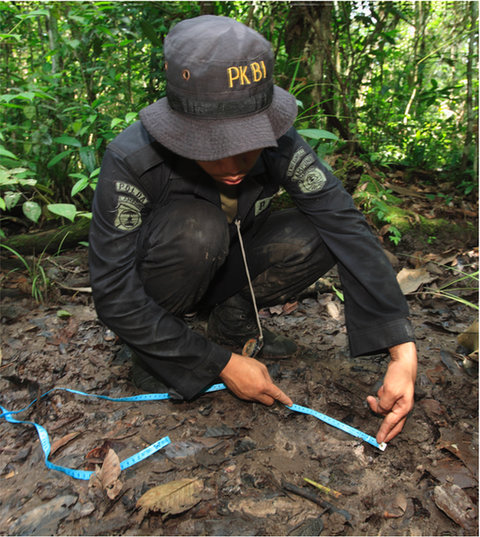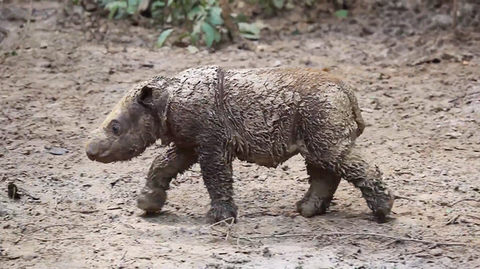Ittookagreatdealofplanningandtheneightlongmonthsofwaiting.Thetraphadbeencarefullyset,buttherewasnorushingtheirtarget.Shedidnotknowshewasbeingfollowed,norwouldshehavecared.ASumatranrhinoworksonits own time.
The conservationists werewaiting,waiting,waiting,andwhen itfinallyhappened,ithappenedunexpectedly.The770‑kilogram(1,700‑pound)Sumatranrhinosteppedontoaleafyspotontheforestfloorandfellintoashallowpit.Theconservationistshaddugthatpitandcovereditwithbranchesandleaves.Believeitornot,thiskindoftrapisthesafestandmosteffectivemethodforcatchingarhino.Butwhydidateamofconservationistswanttotrapa rhino?
It’sallpartofaplan—amultinationalplantosavetheSumatranrhinofromextinction.It’scalledthe SumatranRhino Rescue.

The Sumatranrhinocerosisthesmallestoftherhino family.

ThisrhinoisnowlivingintheSumatranRhinoSanctuaryandissafefrom poachers.
RhinosinTrouble
Allfive speciesofEarth’srhinocerosesarethreatenedwith extinction. Yet,theSumatranrhinoisthemost endangeredofallrhinospecies.Largelyduetopoaching,thenumberofSumatranrhinoshasdecreasedmorethan70percentoverthepast20 years.
Rhinosarekilledfortheirvaluablehorns,whichhavebeenusedforcenturiesintraditionalAsianmedicine.PowderedrhinohornisprescribedbyAsiandoctorsasacureforeverythingfromasthmatochickenpox tonosebleedstosnakebites.Althoughthere’snoproofthatrhinohornshaveanymedicinaleffect,thatdoesn’tstoppeoplefromwantingthem.Rhinohornscansellforpricesthatrival gold.
ARescuePlan
TheSumatran RhinoRescueplanistosafelycaptureasmanywildrhinosaspossibleandthentransferthemtonearbysanctuarieswherescientistscanassistintheir reproduction.

A conservationistmeasuresarhino track.
Rightnow,there’sonlyoneplacewherethatcanhappen.It’scalledtheSumatranRhinoSanctuary.ItwasbuiltbytheInternationalRhinoFoundationinaplacecalledWayKambasNationalPark inSouth Sumatra.
Thisisn’tthefirsttimethatconservationistshavetriedthis.Asfarbackasthe1980s,rhinoswerebeingroundedupforthepurposeof captivebreeding.Theprogramstruggled,though.Notenoughwasknownabouttheserhinostohelpthem reproduce.
Sumatranrhinosaresolitaryanimals.Theycannotbehousedtogether.Arhino’spregnancylastsabout15months.Theonlylandanimalswithlongerpregnanciesareelephants,whichcarrytheirbabiesforabout22months.However,iffemalerhinosgotoolongwithoutbreeding,theydevelopproblemsthatcanpreventsuccessful pregnancies.
ProtectTheNatural World
Protectingtheplanetisvital!TheNationalGeographicSocietyhassetagoaltohelpimprovethestatusof100speciesorpopulationsby 2030.

